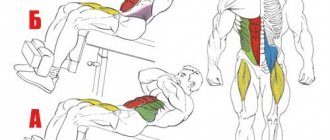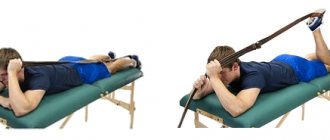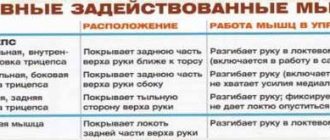So, you bought a press bench
.
What is a press bench
, what is it for and
how to choose the right press bench
we described in our other article.
In this article we will talk about exercises with a press bench
.
What types of press benches are there?
Main types of press bench:
- Direct stationary (now rarely produced)
- Straight with changing angle (most common)
- With curved back
On a classic press bench, when lifting the body, the legs are fixed only at the ankle and the movement is performed with the legs slightly bent at the knees.
Another distinctive feature is the ability to perform leg or knee raises. That is, you can practice either upside down or upside down.
In most designs, the angle of inclination is adjustable. The smaller the angle, the easier it is to perform the exercises. And vice versa, the higher the bench rises, the more difficult it is.
In this way, you can adjust the intensity of the load, which allows you to exercise on the simulator regardless of your level of training.
An abdominal bench with a curved back is positioned as the best option for people with a problematic spine. This design allows you to reduce the load when performing the exercise.
But this is not a panacea. Some people with spinal cord injuries still experience lower back discomfort and have to look for a safer alternative.
What is this simulator?
The press bench is often used by both professional athletes and people who care about the beauty of their own body.
The abdominal bench is a specially designed simulator for active training of the abdominal muscles and lumbar back, which makes it possible to quickly form a beautiful relief of the torso muscles.
Typically, such a machine consists of a short or relatively long bench for sitting and grips (rollers) for the legs, which allows you to perform exercises for flexion and extension of the torso, and also for twisting.
Best exercises
Abdominal exercises on an incline bench can be divided into two large groups:
- Movements with lifting of the torso or shoulder blades
- Movements involving lifting legs or knees
The best exercises with lifting the torso include:
- Partial twisting
- Crunches
- Oblique crunches
Best Leg Raise Exercises:
- Raising your knees to your chest
- Leg Raise
- “Berezka”
We have compiled a list of exercises of increasing difficulty.
If you are a beginner, it is better to start with the first, easier movements.
You should move on to heavier movements as your abdominal muscles strengthen.
Don't forget that you can increase the difficulty of performing movements by changing the angle of the machine.
Other Exercise Variations
Raising the torso on a curved inclined bench can be done not only from a supine position, but also from a prone position. With a sufficient level of physical fitness, you can perform the “scissors” exercise, in which the legs are held completely straight, at an acute angle to the simulator, and alternately moved behind each other with the selected amplitude. Only the load on the abdominal muscles during exercise will be maximum, so you need to exercise very carefully, avoiding traumatic injuries.
Abdominal benches for beginners are not the most necessary exercise equipment, which you cannot do without in the beginning, but with their help you can significantly diversify your workouts at home. The main thing is to take all precautions and avoid overload.
What muscles work
Exercises on a press bench allow you to pump up all the abdominal muscles - both the rectus abdominis and the oblique abdominal muscles.
The muscles of the legs and lower back take an active part in all abdominal movements. Larger and stronger, they often take the lion's share of the load.
In order for abdominal exercises on a bench to be as effective as possible, you need to follow the correct technique and concentrate specifically on the work of the abdominal muscles.
We will tell you how to do this in the next section.
Precautionary measures
Be sure to consult with your trainer and your doctor before starting classes. This is especially true for people over 35 years old, as well as those with problems with the musculoskeletal system and the cardiovascular system. The load exerted on the back and abdominal muscles, on the lower back, is regulated solely by the user. If the load is incorrectly selected, injuries may occur, so it is not recommended for beginners to exercise independently on the bench.
Other precautions include the following recommendations and requirements:
- Installation of the simulator is carried out on a flat, hard surface.
- The minimum distance to walls and furniture must be at least 0.6 m.
- Before starting classes, you should check the tightness of all bolts and the serviceability of other elements of the simulator.
- If you experience dizziness, weakness, nausea, or chest pain, exercise should be stopped immediately.
- The backrest can be cleaned with a damp cloth and a non-abrasive detergent.
- The moving elements of the bench require periodic lubrication.
- When training, use appropriate clothing and shoes - loose clothing during training can get caught in the moving elements of the simulator and tear.
How to properly pump up your abs on a bench
The main secret of the correct abdominal technique is to exclude the leg and lower back muscles from the work as much as possible.
When lifting your body:
- In the starting position, round your back and tighten your abdominal muscles as much as possible.
- Perform a body lift, keeping your abs tense throughout the movement.
- When lifting your body up, exhale; when lowering, inhale.
All repetitions are performed slowly and under control!
Lower yourself down until your torso is parallel to the floor.
If you go below parallel, the abdominal muscles stretch and relax, and this is an unfavorable position for them. From this lowest point, the movement is performed mainly through the lower back.
When lifting your legs:
- At the start, press your lower back to the bench and tighten your abdominal muscles
- Tensing your abs as much as possible as you move, raise your legs up and exhale
- Without relaxing your abdominal muscles, slowly lower your legs down and inhale.
Make sure that when lowering your legs down, your lower back does not come off the bench or bend.
At this moment, the abs relax and the load is transferred to the lumbar muscles. Lower your legs until your back is pressed tightly against the machine.
General rules for performing exercises, how many approaches to do
In order to conduct quality training, it is necessary to comply with certain requirements when performing:
- the pelvis is pressed tightly against the support;
- the stomach is tense;
- neck straight;
- the spine is slightly bent.
Exercises should be performed slowly, without making sudden movements. An acceptable number of sets is 3, 12-16 repetitions each.
Self-pumping of the press should not be carried out earlier than 2 hours after eating. The best time is at the end of the main complex.
Exercising too frequently leads to an increase in waist size. For girls, it is enough to do one or two preparations a week. To avoid overtraining, the body requires 3-4 days of rest to recover.
Recommendations for training
Conventionally, there are two types of abdominal training:
- For tone and muscle growth
- For relief
Training for tone and muscle growth is carried out like for all other muscle groups. But with some differences:
- Frequency of exercise – 2-3 times a week
- Number of exercises - 1-2
- Rep range – 15-25
- Rest duration between sets: 1-1.5 minutes
Training for abdominal relief has its own specifics:
- Training frequency – 3-6 times a week
- Number of exercises – 3-5
- Rep range – 20-30
- Rest duration between sets: 30-60 seconds
To increase intensity, supersets, trisets and circuit training are actively used. But the main role here is played by eating a calorie deficit.
Typical beginner mistakes
Serious sports training does not tolerate carelessness or deviations from the rules. Any inaccuracy can lead to injury or sprain. Before proceeding directly to the training, you should study the technical nuances and features of working with the projectile.
Novice athletes, due to inexperience, quite often make the same mistakes:
- Separation of the lower back from the support, or a strong deflection of the body. Such actions can overload the hip area and remove stress from the abdominal muscles.
- Holding your breath while working. Timely supply of air saturates all cells and tissues of the body with oxygen. Holding your breath is a dangerous mistake that can harm the nervous system.
- Neglecting the recommended standards for the number of repetitions and approaches.
- Implementing daily ab pumping is a typical and gross misconception for beginners.
- Conducting a workout on a full stomach. To prevent unpleasant reactions such as vomiting and nausea, at least 1.5-2 hours should pass after eating. Shortly before training, it is not recommended to have a heavy lunch. A light snack is a good option before class.
The most common mistakes
Despite the fact that the exercise is of average difficulty, most athletes do not avoid mistakes at the beginning of their journey. And here are the most common:
- Fix the body in a straight position throughout the entire exercise. This option cannot be called twisting. These are lifts of the torso, where the neck and lumbar muscles work.
- Many novice athletes immediately set the bench position too steep. You need to start with a bench with a slight incline and move on to a more complex option only after mastering the technique.
- Clasping your hands behind your head. In this case, the arms try to push the athlete upward. This can lead to an unnatural position of the neck and, as a result, injury to the vertebrae of the neck, curvature of the spine in the upper part.
- Lifting the lower back off the bench.
What are the benefits of abdominal crunches?
I would like to note right away that crunches are not an exercise identical to sit-ups or sit-ups. In crunches, the amplitude is not so important to us; here there is absolutely no point in lifting the body to a right angle, but rather the continuous work of the abdominal muscles and control of movement - for this we slightly round the back in the thoracic region. This slight kyphosis is acceptable and does not increase the risk of injury.
The good thing about crunches is that by choosing one or another type of crunch that we will do in training, we can regularly add variety to the training process and work out certain parts of our abdominal muscles in isolation.
Because of this, I consider crunches the #1 exercise for developing abdominal muscles. It is quite simple, it is easy to feel the contraction and stretching of the working muscle group, most of its types do not require additional equipment, and with the help of crunches you can properly work out the muscles of your abs in just 10-15 minutes - an excellent option for those people who cannot devote much time to training.
© Makatserchyk — stock.adobe.com
Advice from experienced athletes
If the exercise is difficult, you can first cross your arms over your chest or hold them on the bench.
When performing crunches on an incline bench, you can lower yourself completely (lie down on the bench) or to a level where your body is parallel to the floor. In the first case, the amplitude of movement is greater, in the second case, the abdominal muscles contract harder and faster.
There is an opinion that there is nothing bad in the fact that the lumbar muscles are included in the work when the lower back is lifted off the bench. But if you need to exclude them from work, then you need to twist your back only in the thoracic region, and press your lower back as hard as possible against the bench.
Crunching is an exercise that must be performed regularly, otherwise it will not give results. It is not enough for abs to appear. Cubes are an indicator of a low fat percentage, and to achieve this, you first need a thoughtful diet.
Incline crunches
Now let's move on directly to the exercises that can be performed on an incline bench. Crunches can be done in the classic way, in which you lift your body straight, or with a twist, when you lift your body to the side.
Please note that incline crunches are contraindicated for people suffering from hypertension, intracranial pressure or frequent migraines.
Technique for performing classic crunches
When performing crunches, it is important not to lift your lower back from the surface, only your shoulder blades.
- We sit on the bench, secure our legs under the bolster and lie down with our whole body - hips, lower back, shoulder blades and head lie on the bench.
- We put our hands behind our heads.
- We take a deep breath and, as we exhale, use the abdominal muscles to lift the upper part of the body. We tear off only the shoulder blades from the bench, the lower back is still pressed to the bench.
- Do not put pressure on your head with your hands; try to lift your body with your abdominal muscles. At the top point, exhale and tense your abs.
- We return to the starting position and relax the muscles.
We perform 3–4 approaches. The number of repetitions may vary depending on how long ago you started exercising: on average, from 8-12 times for a beginner to 15-20 times for an experienced athlete.
Video: correctly pump up the crunch press on a Roman bench
Video on how to properly pump up your abs when performing crunches on an incline bench:
Technique for performing crunches with rotation
- We sit on an inclined bench, fix our shins under the bolster and lie down.
- The shoulder blades, lower back, hips and head lie completely on the surface of the bench.
- Place your palms on the back of your head.
- Take a deep breath and, as you exhale, lift your upper body. The lower back should remain on the bench.
- In this case, the elbow of the right hand tends towards the left knee, and the left elbow - towards the right.
In this version of crunches, primarily the internal and external oblique and serratus abdominal muscles are loaded.
Number of repetitions: 15–20, 3–4 sets.
Video: crunches with rotation on an incline bench
Video of abdominal swing using crunches with rotation on an incline bench:
Contraindications
It is important to know in what cases an exercise should be abandoned. These contraindications can be absolute (permanent) or temporary. These include:
- Stomach ulcer in the acute stage. During an exacerbation of the disease, it is contraindicated to visit the gym, since loads, including twisting on an inclined bench, can lead to a deterioration in well-being.
- Recent surgery.
- Spinal hernia. This is not a reason to give up training, but you should give up crunches on an incline gymnastic bench.
- Benign tumors of the abdominal cavity.
How to choose the right simulator
The case is of no small importance: it must be made of strong fabric so that it can withstand any load. The quality of the porous material for leg braces also matters.
The modern market for sports goods includes the following brands that offer inexpensive options for abdominal exercise equipment for comfortable use at home. These are Torneo, Atemi, Stingrey, Body Sculpture and others.
You need to choose a board for your abs, taking into account the general physical fitness of the body, the state of the health of the back, the frequency and intensity of the intended training. In addition, it is important to pay attention to the fact that the working surface of the board is covered with natural soft fabrics that do not cause allergies.
So, abdominal exercises on a special machine - an abdominal bench - are a very effective way to pump up those very abs that are so often talked about. But remember that this method will not help remove belly fat. For this, in addition to exercises on the bench, you need a special diet, as well as other physical activities, for example, running is very effective in this case.
Do you need a bench press bench at home?
Of course, you can do without exercise equipment at all, but if your goal is to gain weight and maintain the tone of all the muscles of the body, then you cannot do without at least one universal exercise machine. For a bench press, you also need dumbbells of various weights or a barbell, but provided that the bench has racks. If you want to develop large pectoral muscles and back, without a bench press it is unlikely to achieve results with push-ups alone.
How to pump up abs for a man
Men, first of all, need to focus on the size of the rectus muscle - perform exercises with weights in the range of 8-15 repetitions. Do not neglect the safety belt in basic movements, but also do not wear it where it is not needed, because... he will simply “steal” the load from the press.
Exercises:
We recommend reading: The strongest muscle in the human body
- Crunches on a 4x10 block;
- Hanging leg raises (with weights) 3x10;
- Crunches with 4x8 top block;
- Burpee 4x20;
- Pull-ups “Corner” 4x10.
What is an ab board
The exercise machine consists of a steel frame, a durable incline bench and rollers that fix the legs during exercise. Exercises on an incline bench are considered more effective than in a horizontal position. There are several types of simulator:
- Cast construction with fixed angle. The disadvantage of such a simulator is that the inclination of the bench is always constant, so the degree of load cannot be changed.
- A machine with adjustable rollers and a bench is more functional; you can adjust the degree of load on it.
- The folding press bench is suitable for home workouts, it is convenient to transport, and it takes up little space when folded.
- The exercise machine with a curved back does not overload the back and reduces the risk of injury. People with back problems need to exercise on a curved bench.
- A bench with a barbell frame expands the training possibilities: it not only pumps up the abs, but also works the muscles of the back and arms with the help of a bench press.










